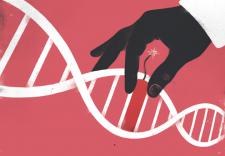Are we mapping a path to CRISPR babies?
By Katie Hasson and Marcy Darnovsky,
The Hill
| 09. 13. 2020
In November 2018, at a gene-editing “summit” hosted by scientific societies from the U.S., the U.K., and Hong Kong, a Chinese researcher announced that he had created the world’s first genetically modified babies. He Jiankui fully expected to be celebrated for a scientific breakthrough; he mentioned the Nobel Prize. Instead, he was almost universally condemned.
Key figures associated with the U.S. National Academies and U.K. Royal Society joined in the criticism but did not reject heritable genome editing. Instead, they objected to the Chinese researcher’s timing. It was too soon, they said. It hadn’t been done as they thought it should have been. But according to the researcher now being called a “rogue,” it was the National Academies’ 2017 report that had given him the green light for his experiments.
In the aftermath of this headline-grabbing debacle, the scientific societies decided on a do-over. They declared it time to “define a rigorous, responsible translational pathway” toward clinical use of heritable genome editing. They set up a carefully selected international commission with the mandate to map the scientific details...
Related Articles
By Anumita Kaur [cites CGS’ Katie Hasson], The Washington Post | 03.25.2025
Genetic information company 23andMe has said that it is headed to bankruptcy court, raising questions for what happens to the DNA shared by millions of people with the company via saliva test kits.
Sunday’s announcement clears the way for a new...
By Peter Wehling, Tino Plümecke, and Isabelle Bartram
| 03.26.2025
This article was originally published as “Soziogenomik und polygene Scores” in issue 272 (February 2025) of the German-language journal Gen-ethischer Informationsdienst (GID); translated by the authors.
In mid-November 2024, the British organization Hope not Hate published its investigative research ‘Inside the Eugenics Revival’. In addition to documentating an active international “race research” network, the investigation also brought to light the existence of a US start-up that offers eugenic embryo selection. Heliospect Genomics aims to enable wealthy couples to...
By Frank Landymore, Futurism | 03.18.2025
You can only throw so much money at a problem.
This, more or less, is the line being taken by AI researchers in a recent survey. Asked whether "scaling up" current AI approaches could lead to achieving artificial general...
By Craig S. Smith, Forbes | 03.08.2025
One recent evening in Shenzhen, a group of software engineers gathered in a dimly lit co-working space, furiously typing as they monitored the performance of a new AI system. The air was electric, thick with the hum of servers and...




